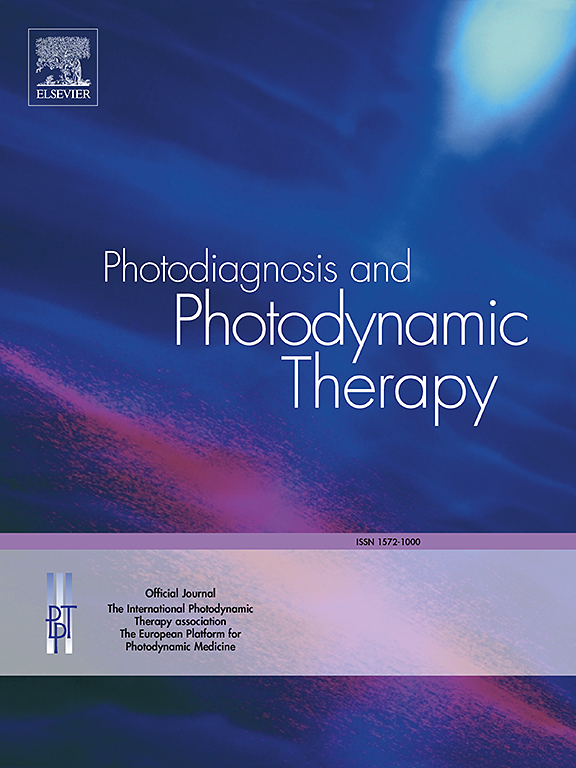使用吲哚菁绿负载纳米球对两种牙周物种的多微生物生物膜进行光动力破坏。
IF 3.1
3区 医学
Q2 ONCOLOGY
引用次数: 0
摘要
目的:抗菌光动力疗法(aPDT)被认为是治疗生物膜感染的一种潜在方法,由于抗菌药耐药性的增加,生物膜感染已成为一个日益严重的健康问题。本研究旨在评估吲哚菁绿纳米球(ICG-Nano/c)对多微生物牙周生物膜的杀菌效果:方法: 在 96 孔板中构建牙龈卟啉菌和戈登链球菌的复合生物膜,用 ICG-Nano/c 和 810 nm 的二极管激光进行直接照射或通过 3 mm 厚的牙龈模型透射照射。将基于 ICG-Nano/c 的 aPDT 的疗效与抗生素(米诺环素和阿莫西林)进行了比较。此外,利用实时聚合酶链式反应,研究了亚致死条件下减毒 APDT 的抗氧化反应相关基因表达(牙龈脓疱病菌的 oxyR 和 sod)以及通过法定量感应形成生物膜的相关基因表达(两种病菌的 luxS):结果:基于 ICG-Nano/c 的 aPDT 能显著减少生物膜中的细菌数量,两种照射方法都能在 5 分钟内将菌落形成单位至少减少 2 log10。治疗 6 小时后,aPDT 和抗生素的杀菌效果相似,但 32 小时后,抗生素的杀菌效果更好,尤其是对牙龈脓杆菌。衰减的aPDT在牙龈脓杆菌中的sod表达量略有增加,而在这两种细菌中的luxS表达量都有所下降:结论:基于 ICG-Nano/c 的 aPDT 系统对牙周细菌的复合生物膜具有一定程度的杀菌活性。因此,它有可能成为牙周治疗中传统抗生素的替代选择或辅助疗法。本文章由计算机程序翻译,如有差异,请以英文原文为准。
Photodynamic disruption of a polymicrobial biofilm of two periodontal species using indocyanine green-loaded nanospheres
Objective
Antimicrobial photodynamic therapy (aPDT) is considered a potential treatment for biofilm infections, which have become an increasing health issue because of the rise in antimicrobial resistance. This study aimed to evaluate the bactericidal effect of aPDT using indocyanine green-loaded nanospheres with chitosan coating (ICG-Nano/c) against polymicrobial periodontal biofilms.
Methods
Composite biofilms of Porphyromonas gingivalis and Streptococcus gordonii were constructed in 96-well plates, and aPDT with ICG-Nano/c and an 810 nm diode laser was performed either by direct irradiation or transmitting irradiation through a 3-mm-thick gingival model. The efficacy of ICG-Nano/c-based aPDT was compared with antibiotics (minocycline and amoxicillin). Additionally, attenuated aPDT under sublethal conditions was used to investigate gene expression related to the antioxidant response (oxyR and sod of P. gingivalis) and biofilm formation via quorum sensing (luxS of both species) with real-time polymerase chain reaction.
Results
ICG-Nano/c-based aPDT significantly reduced the bacterial load in the biofilm, achieving at least a 2 log10 reduction in colony-forming units within 5 min for both irradiation methods. After 6 h of treatment, the bactericidal effects of aPDT and antibiotics were similar, but after 32 h, antibiotics were more effective, particularly against P. gingivalis. Attenuated aPDT showed a slight increase in sod expression in P. gingivalis, while luxS expression decreased in both bacteria.
Conclusion
The ICG-Nano/c-based aPDT system exerted a certain degree of bactericidal activity against a composite biofilm of periodontal bacteria. Therefore, it has potential as an alternative option or adjunctive therapy to conventional antibiotics in periodontal treatment.
求助全文
通过发布文献求助,成功后即可免费获取论文全文。
去求助
来源期刊

Photodiagnosis and Photodynamic Therapy
ONCOLOGY-
CiteScore
5.80
自引率
24.20%
发文量
509
审稿时长
50 days
期刊介绍:
Photodiagnosis and Photodynamic Therapy is an international journal for the dissemination of scientific knowledge and clinical developments of Photodiagnosis and Photodynamic Therapy in all medical specialties. The journal publishes original articles, review articles, case presentations, "how-to-do-it" articles, Letters to the Editor, short communications and relevant images with short descriptions. All submitted material is subject to a strict peer-review process.
 求助内容:
求助内容: 应助结果提醒方式:
应助结果提醒方式:


